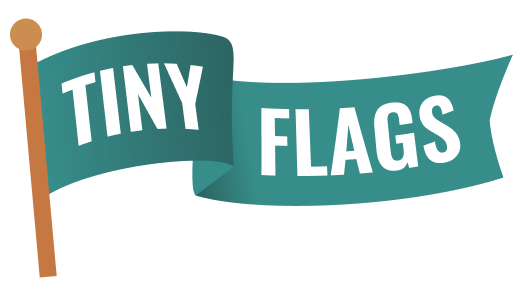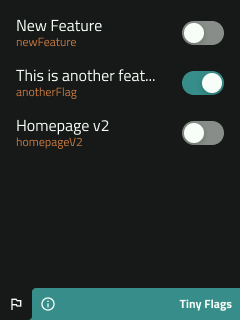🚩 What is this? Feature flags for ants?
Well, yes! Antiny
Let PMs, designers, fellow developers or even clients try your awesome new features without worrying about waiting for the whole thing to be finished or blocking a release.
Tiny Flags is a great option when you don't want to pay for a third-party provider. Every user of your application can update the flags' status without the need of re-deploying, allowing them to test in a real environment.
This project also provides full TypeScript support when using the useFlags hook.
🪄 Demo
Want to see it in action? Check out the demo.
Also, you can check this CodeSandbox to play with the code.
📦 Installation
npm i tiny-flags🧑💻 Usage
Setup
First, you'll need a configuration:
// tiny-flags.ts
import { createTinyFlags } from 'tiny-flags';
const flags = {
newFeature: {
label: 'New Feature',
value: false, // value is not required
},
anotherFlag: {
label: 'This is another feature enabled by default',
value: true,
},
};
export const { FlagsProvider, useFlags } = createTinyFlags(flags);Then you can wrap your application with FlagsProvider.
import ReactDOM from 'react-dom/client';
import App from './App';
import { FlagsProvider } from './tiny-flags';
ReactDOM.render(
<React.StrictMode>
<FlagsProvider><App /></FlagsProvider>
</React.StrictMode>,
document.getElementById('root')
)Hook
Import useFlags in your components to check your flag's status.
// component.ts
import { useFlags } from './tiny-flags';
const App = () => {
const flags = useFlags();
return (
<div>
This will show if
{ flags.newFeature && <div>Ta-da! 🎉</div> }
</div>
);
};
export default App;Component
You can also use the FlagsWrapper component to wrap your components and check the flag's status.
The FlagsWrapper component receives a condition prop that can be a string, an array of strings or a function.
- If the condition is a string, it will check if the flag is enabled.
- If the condition is an array of strings, it will check if all the flags are enabled.
- If the condition is a function, it will check if the function returns
true.
// component.ts
import { FlagsWrapper } from './tiny-flags';
const Component = () => {
return (
<FlagsWrapper condition="newFeature">
<div>Ta-da! 🎉</div>
</FlagsWrapper>
);
};
export default Component;Make sure to import
FlagsProvider,useFlagsandFlagsWrapperfrom thetiny-flagsconfiguration file and not thetiny-flagspackage.
🧩 Extension
This library establishes a two-way communication with the Tiny Flags Extension so you can see the available flags and also toggle their state.
⚠️ When not to use?
- You need to remotely update your flags
- You need complex rules or different audiences for your flags
- You don't want your flags to be exposed


